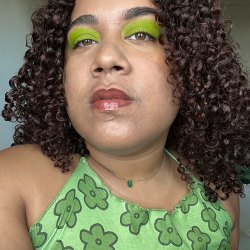There was ‘Cowboy Caviar, then ‘sticky bangs’ and now there’s another trend that is receiving major backlash (and a serious eye roll from yours truly) for whitewashing something that has long been part of certain communities. Let me introduce you to ‘Mamma Mia Hair’ or what the natural hair community has always called a twist out. Now, I can totally get behind a cute TikTok name for a new, fun beauty trend (hello, Kitty Cut), but this one is a prime example of something that should not be rebranded.
Why I Am Not Interested In the Mamma Mia Hair TikTok Trend
Don’t go wasting your emotions on this *new* style
Wait, What Is Mamma Mia Hair?
The hair method was ‘introduced’ by creator Morgan Maynor as a heatless alternative for beachy waves. Inspired by Amanda Seyfried in the 2000s musical, it surged in popularity for those with straight to wavy hair. According to Google Trends, the search interest for ‘mamma mia hair’ has become a breakout term, though ‘twist out hair’ has increased by 1400 percent in the past week of writing this (but I’ll get to that in a second).
If it looks familiar, it’s because the hair trend is not new. It’s actually a twist out (or a braid out) that has been around in the natural hair community for ages. So, what exactly is a twist out? It consists of sectioning hair into multiple twists, letting it dry (or leaving it overnight) before unraveling in the morning to reveal bouncy curls. It can be used as a regular hairstyle for defined, uniformed hair or a protective style to sleep with overnight.
Why Is Mamma Mia Hair So Problematic?
Similar to ‘Cowboy Caviar’ or the ‘Clean Girl Aesthetic,’ the trend erases the originators. Black women have been traditionally rocking this natural hairstyle, but once again, ‘Mamma Mia Hair’ puts white women front and center in the trend. A quick look at the hashtag and you’ll find one specific hair type, which alienates and erases the original concept.
As one Redditor shares, “People who don’t get it yet: the problem is how the styles are viewed depending on the race of the person. On white people, it’s ‘mamma mia hair,’ but on Black [and] Brown people, it's unruly and untamed hair, [which] literally affects our quality of life because of this perception. People are frustrated because rather than acknowledging it’s wrong to discriminate like this, people would prefer to repackage this to be more palatable and that is white supremacy’s effect on the world.”
Despite states passing hair discrimination laws, biases and microaggressions still exist around natural hair. For a long time, many styles (like twist out hair) were seen as unprofessional, unruly or unattractive. Just look at the coverage surrounding Simone Biles and her hair at the Paris Olympics. Bottom line: It’s not only about the name. It’s about how harmful it can be for the trend to strip away the origins, the culture and overall the history.
So, What Can I Do Instead?
I’m in no way saying you can’t do a twist out. Regardless of your hair type, it’s honestly a great hack that I’ve been using for years, especially when I was starting my natural hair journey. It’s a heatless technique that doesn’t require a curling iron, and you can rock it as is or wear it to bed. It’s also super easy to do and doesn’t require a degree to figure out.
What I am saying is not every trend needs a snappy name. One TikTok creator said it best: “The problem with rebranding it—because I understand things get rebranded all the time—it’s rebranded and white people do it becomes culturally acceptable. So go through and rename all your videos. It’s not ‘Mamma Mia Hair,’ it’s called the twist out. It’s just important to give credit where credit is due.”
Let’s be clear: I love Mamma Mia and will sing along every time. But it should stick to being an iconic movie and not the subject of an already established hairstyle. If you want to live out your Sophie dreams, go for it. Just stop renaming and changing BIPOC beauty looks, please.




